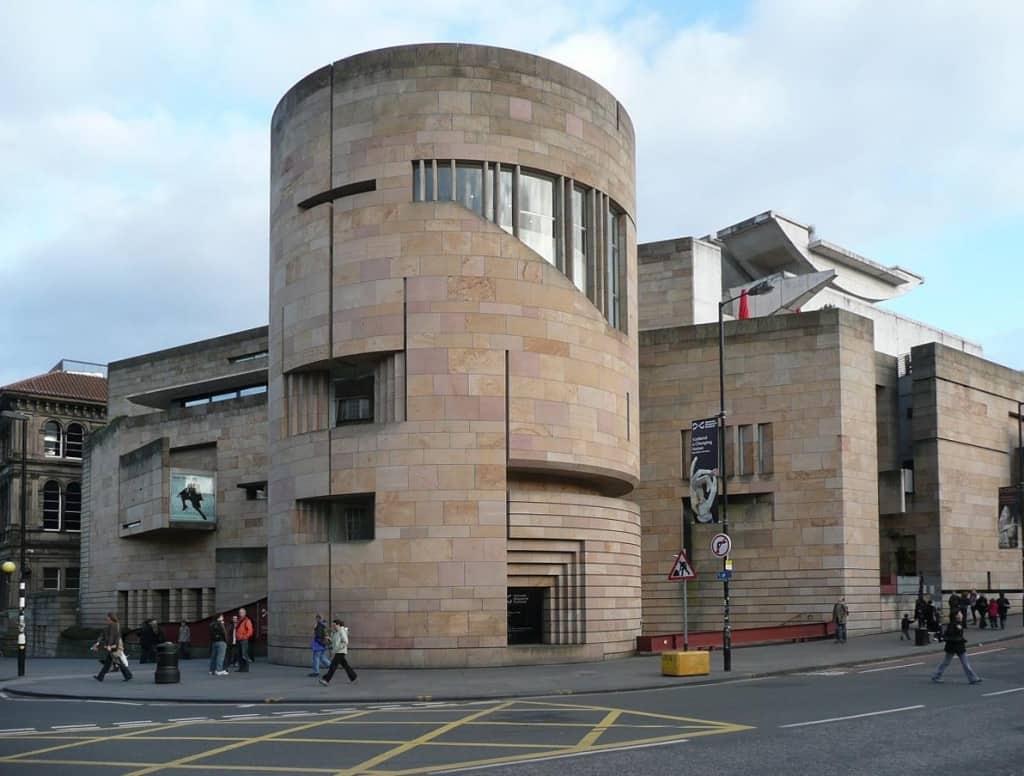(Photo: Graham van der Wielen, Wikimedia.)
The National Museum of Scotland
Guest post by J. P. Wegner, reproduced with the author’s permission from The Shadowland newsletter, n° 69, December 2016.
The Shadowland newslatter is archived by Pandora, Australia’s web archive.
The National Museum of Scotland is a large, modern but general museum. Like most general museums, the National Museum of Scotland has to cover a very large area such as the natural world, world cultures, science and technology, art, design and fashion, &c. My personal guide regretted that they did not have a great deal on show relating to printing but with much more in storage. Gone are the days when you had items arranged in galleries by subjects such as printing and paper, &c. Most museums today are interpretative rather than enumerative and so there are many small exhibitions spread over the seven floors of the museum. Exhibitions such as Patterns of life, Fashion and style, Performance and lives, Survival, Artistic legacies, Art of living and Design for life. The modern building on the corner is devoted to Scotland with each floor one special theme such as Scotland transformed and Industry and Empire.
But there is more than you would at first have imagined. It is worth noting that they have thought to put their Columbian (T.1964.1) as one of the few special items on display in the most prestigious space—the Grand Gallery. It was made in Edinburgh around 1860
and was still in use at the museum printing labels a hundred years later. Something no less interesting but which most no doubt will miss is the scale model of the museum made on the occasion of its one hundred and fiftieth anniversary by ‘Scottish brick artist’ Warren Elsmore totally out of Lego blocks. This includes a scale model of the Columbian (cf. SN#69.18 below). Now if only they had some of those for sale in the museum shop!
Most of the printing exhibits naturally relate to Scotland in some way and so most are displayed in the Scottish wing of the museum where there are quite a number of historically significant items of machinery and equipment:
- Baby Albion printing press made by Harrild, no. 1630, 1864 (T.1960.7)
- A selection of the composing department from William Collins & Co., ca. 1900 (from the Scottish Printing Archival Trust)
- The first rotary printing press – As in the model invented by Thomas Nelson of publishing fame in Edinburgh, 1850 (T.1980.180)
- A rare and early model Paper making machine, quarter scale and made in Edinburgh in 1860
- Dandy roll with Cowan watermark
- An early framed poster of the Paper mills of Scotland, makers’ names
- The important early large Book of paper samples from A. Cowan & Sons’ Valleyfield Paper Mills, ca. 1840 to ca. 1880
- Museums in the past used to make scale models of machinery rather than display actual examples. Here also such a model of a guillotine.
But if you look closely, you can discover important items on the subject of printing scattered throughout the building such as:
- Foster’s printing press model – A scale model of a newspaper printing press incorporating printing and folding in the one machine. The press was made by the museum staff in the 1880s and has been used to print miniature editions of The
Scotsman newspaper (T.1888.819) - On the first floor in the Discoveries exhibition area there is a special display of printing blocks for Chambers’s encyclopaedia. The National Library of Scotland holds the Chambers archive but at the time the printing blocks were passed on the museum which was going to select a sampling of them to keep. Thankfully there were so many and at the time they didn’t have the staff to do this and so the blocks were all kept. Proofs of them are held in the museum library—the volume I saw was of 269pp.—and I believe a researcher is going through them with the aim of digitizing and matching blocks to image.
- But there are also more subtle links such as the wonderful scrap book of early Scottish bill heads.
A great deal of the material held by the National Museum of Scotland on these subjects is in storage. The museum does have a search page but this is still a work in progress and I did not have a great deal of success with this. (I don’t believe there is an inventory by subjects available either). The curators were very helpful in providing me with some results which included:
- Printing press made by Messrs. Anderson in business at Leith Walk Foundry, 1811-1843 (T.1923.10)
- Stanhope printing press on a wooden base (T.1928.6)
- Printing press of wood … with the platen missing, probably 18th century (T.1962. 82)
- Inking table and roller for a Columbian printing press made by D. and J. Greig of Edinburgh, ca.1865 (T.1964.1A)
- Titan hand-operated printing press by Miller and Richard (T.1975.94)
- Small hand cranked printing press for making cartes de visit including photographs, A. Magand, Paris, ca. 1900 (T.1978.80)
- Hand operated litho press by D. and J. Greig, Edinburgh, ca. 1890 (T.1983.175)
- Cossar web newspaper printing press used to print till 1991 by Payne and Sons, Otley, ca. 1907 (T.2012.41.1)
- Double crown Wharfedale, Thomas Long and Co., Edinburgh, ca. 1842-1882 (T.1972.91)
There are also some more modern items such as:
- Heidelberg 10 by 15 inch platen, ca.1960 (T.2009.98)
- Monotype typesetter (T.1979.11A)
- Adana, 3.75” x 2.25”, ca. 1946 (T.1980.109)
I imagine arrangements could be made to look at the above by any serious researcher though not for the general printing enthusiast.
NMS website: http://www.nms.ac.uk/national-museum-of-scotland/
All museums search: https://www.nms.ac.uk/explore-our-collections/search-our-collections/
History of the NMS: http://www.nms.ac.uk/about-us/history-of-national-museums-scotland/
